Please note that your subscription plan determines the specific set of features available to you, which may result in differences between what you see and the images presented in this article. For further details on the features included in your plan, please contact your OfficeSpace Admin.
Booking Utilization reports present you with data about bookable desks in a straightforward way. Using real-time data on current bookable desk statuses, the reports generate a snapshot of booking utilization that can be used for analysis purposes.
Whether or not a booking has taken place is determined by the status of the booking. A booking is considered to have taken place if it falls under one of the following booking statuses:
- The booking is ongoing or pending
- The booking has ended
- The booking was completed as a result of reaching the end of the booking window
If a booking has been declined or canceled, or a user has failed to check in, then this booking will not have taken place at all, in the context of the report. These reports also consider bookings completed by both active and inactive employees (prior to their deactivation).
Daily BookingsBooking DemandBooking TrendsBooking FunnelBooking Usage by OccupantBooking Usage by DeskBooking Capacity Limits
Daily Bookings
This report allows you to understand when each booking in a given day was made, and the identity of the person occupying the desk. Using the
date picker (1), you can choose a specific date to examine.
Note that the start and end times of the booking are based on the local time of the location where the booking was made. For example, a booking made at 3 pm in Hong Kong will show as taking place at 3 pm, even if the report is generated in a different time zone.
Use the
bookings picker (2) to filter which results are shown.
Select
All Bookings to display a list of all of the bookings for a particular day.
The
Checked - In Only option displays bookings that both required check-in and that were successfully confirmed by the user. Included in this total are any bookings in which an employee was automatically checked in.

Booking Demand
The Booking Demand Report compares the number of desks being booked to either:
- The number of bookings available on the floor, or
- A predetermined limit set by your System Admin
Using this information, you can see the number of desks required for a particular day within a given time frame.
The default option for this time frame is Next 14 Days, but it's possible to enter a specific date range if you select Custom from the
date range picker (1).
You can also choose to include or exclude pending booking requests, using the
pending requests picker (2).

Booking Trends
This report shows you the number of active bookable desks, the bookable limit, and the total the per-day breakdown of booked desks, for one or more chosen sites.
With the
view selector (1), you can toggle your view of the data in the Booking Trends report by site or by department.
The
floor picker (2) defaults to On-line floors, but you can use it to view the data for a different group over your chosen period. Using the picker menus, you can select a specific
date range (3) or choose a custom date, choose the
utilization period (4), and, if you've chosen the hourly utilization period,
start and end times (5).
You can also view the data in the report on a per floor basis by selecting the
expander icon (6) to the left of each site name.
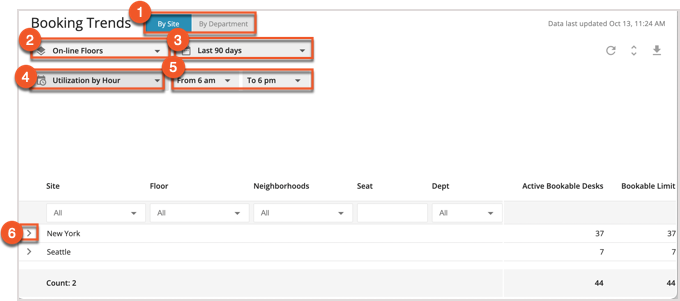
By scrolling to the right in the report, you can see the
exact number of bookings per day or per hour, depending on your chosen utilization period.
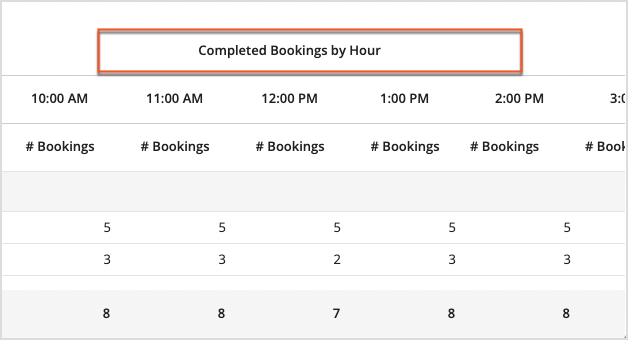
Booking Funnel
With this report, you are able to see the data relating to active bookable desks that are present on each floor plan for your organization, and examine the data from each step in the booking process.
Included in the Booking Funnel are both Self Service and By Request desks. Using the
date range picker, you can also choose a date range to narrow down your data.
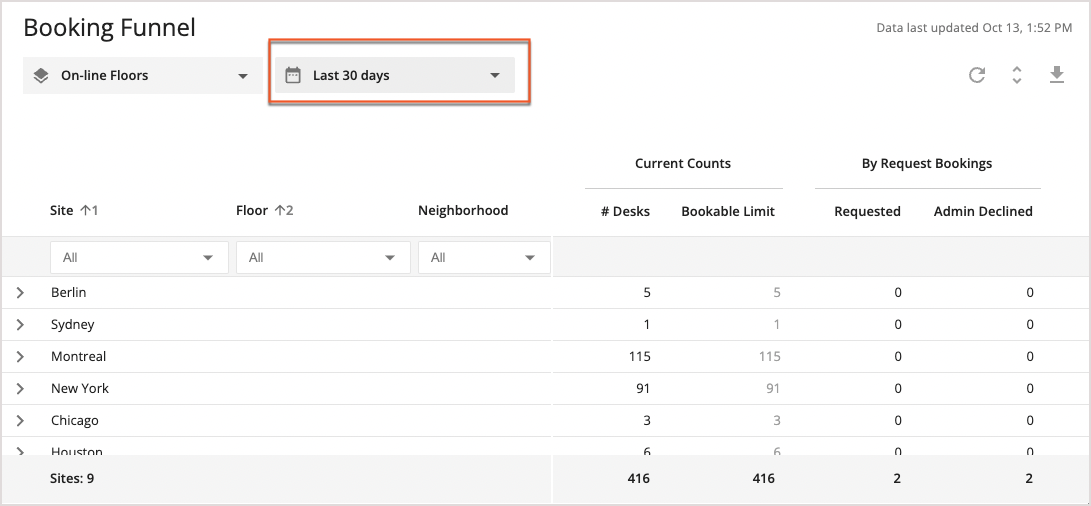
There are many different categories to sort data by in this report. A full list is below:
Current Counts includes the number of active bookable desks (
# Desks) and the maximum number of simultaneously available, bookable desks per floor (
Bookable Limit).
Self Service Bookings includes the total number of self-service bookings that are scheduled to occur within the date range selected.
Cumulative Bookings is a large category, including all of the following:
| Status | Explanation |
|---|
| Scheduled | The total number of bookings made during the period. The other statuses make up a portion of this number. |
| Yet to Start | The total number of bookings that are still to commence |
| In Progress | The total number of bookings that are currently in progress. |
| Ended Early | The total number of bookings aborted before their scheduled end time |
| Completed | The total number of bookings that have finished |
| Canceled | The total number of bookings that have been terminated |
Finally, the Cancelled Bookings category includes the following categories :
| Status | Explanation |
|---|
| Check-in Fail | The total number of scheduled bookings that were cancelled due to a failure to check in. |
| Safeguard Fail | The total number of scheduled bookings that were cancelled due a failed Safeguard result. |
| By Occupant | The total number of scheduled bookings that were cancelled by the seat occupant. |
| By Admin | The total number of scheduled bookings that were cancelled by the Admin. |
| % of Bookings that were vanceled | The percentage of scheduled bookings cancelled for any reason. |
| % of Bookings canceled due to failed check in | The percentage of scheduled bookings that were cancelled by a failure to check in. |
This data is incredibly useful for understanding not only the number of cancellations or their frequency, but also can be used to infer employee behavior that results in cancellation. Examples of employee behavior could include employees "saving" specific desks for themselves by reflexively booking them, or saving them for coworkers by ending their booking consistently at the start of another employee's booking.
Booking Usage By Occupant
Using the Booking Usage By Occupant report, you can review how frequently an employee uses desk booking features, including statistics on the number of days they've booked, the number of days that they've been able to book, and their usage of desk booking features given as a percentage of the time they've been able to book. The report displays all active employees with bookings.
Using the dropdowns, it's possible for you to select a custom
date (1) and to decide whether or not to
include or exclude those with 0 bookings (2). If those with 0 bookings are excluded, they will not be displayed as part of the data.
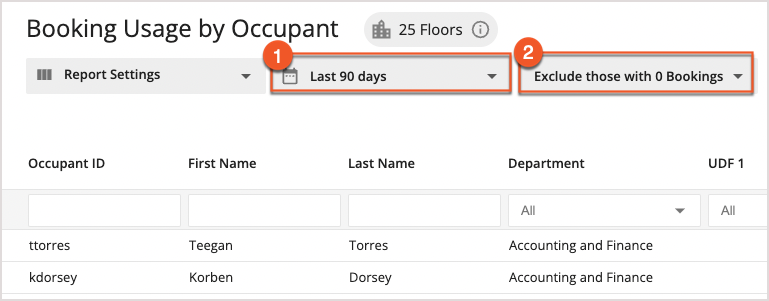
Booking Usage By Desk
The
Booking Usage By Desk report allows you to review how often a specific desk is booked by employees in your organization.
This report gives the number of days that the desk has been available to book, the number of days it's been used, and the number of days the desk has been booked as a percentage of the total number of days that it could have been booked. Additionally, it's possible to view the time a seat has been booked over a date range as a percentage, relative to the date range selected.
Using the dropdowns, you can set a specific
date range (1) to view, and
include or exclude desks with 0 bookings (2). There is also a
toggle (3) which will color the % Used column according to the amount of usage--red for low utilization, and green for higher utilization. This information can be useful when trying to determine the reasons for desk popularity. For example, a desk with low utilization may have missing or broken equipment, and a desk with high utilization may be in a much quieter area.
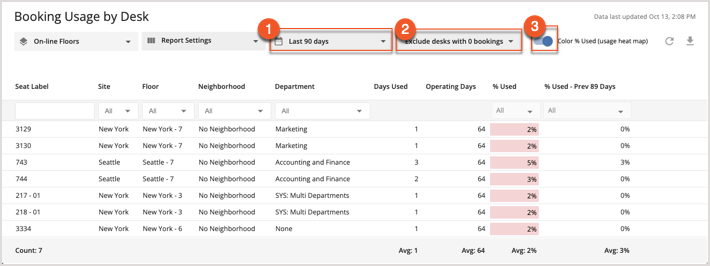
Booking Capacity Limits by Floor
With the Booking Capacity Limits by Floor report, you can view and set limits on the number of seats that can be booked at any one time on a floor.
Using the
edit icon (1), you can also set a maximum limit to the number of bookings-per-floor that can be active at any given time. To do so, just edit the
Bookable Limit column (2) for the particular floor.
If the bookable limit has not been manually set, it defaults to the number of active bookable seats on that particular floor.




